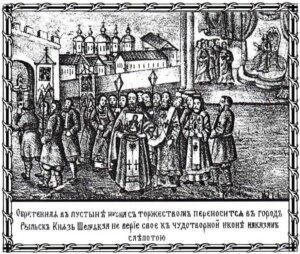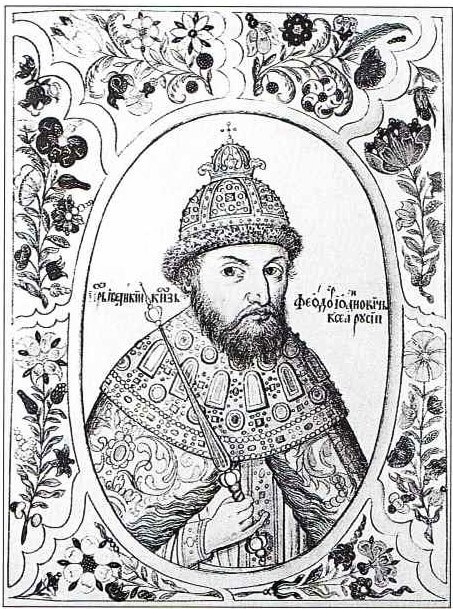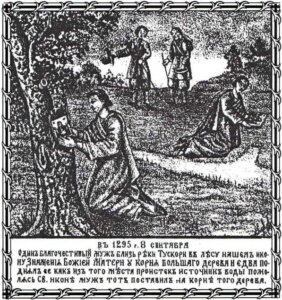The miraculous acquisition of the icon of the Sign of the Most Holy Theotokos at the root of a tree and the history of its glorification until the founding of the Root Hermitage. The Original History of the Miraculous Kursk Icon of the Sign of the Most Holy Theotokos, with a brief description of the signs of God's mercy revealed by her, set out in a written monument of the 17th century. This monument, very common in the Kursk region and beyond, known in several lists, very, however, similar to each other, and under different names. The most complete of the latter is: "The Tale of the Apparition of the Miraculous Icon of the Most Pure Mother of God, her honest and glorious banner, hedgehog is called Kursk, and about the city of Kursk, it is revealed in a nutshell, and about miracles from this miraculous Icon of the Most Holy Theotokos, and about the deliverance of the city of Kursk, Cherkasy invasion, from captivity and other miracles”.
According to the information provided by the Tale, the appearance of the miraculous image of the Sign of the Mother of God followed in a terrible time for the Russian people, during the terrible Tatar yoke that weighed on him. In this disastrous time for our ancestors, when many Russian cities and villages were ruined, devastated and depopulated by rude barbarian victors, Kursk with the region that belonged to him did not escape the common miserable fate. It was turned by Batu Khan into a pile of ruins., and its inhabitants were captured or fled to secluded places, saving your life and property. Savagery and prolonged extreme desolation settled in the ruined city and in its entire circumference.. The intolerable oppression of Mongol slavery for the Russian people was further aggravated by other equally grave disasters. – by hunger, pestilence and military devastation. And since in all the phenomena of the world and his life he was looking for a religious meaning, even in the calamities that befell him he acknowledged the wrath of God, I saw His will and heavenly punishment for my sins. In such pious views of their contemporaries, the scribes and pastors of the church affirmed, calling on their impoverished flock to moral correction, to good deeds, fasting and prayer. Not having, due to their ignorance, scientific means and rich material wealth, Russians were powerless to fight the misfortunes that oppressed them, and that's why, listening to the voice of their shepherds, turned to the Lord for help. And their prayers were not in vain. The merciful Lord visibly showed his help and alleviated the plight of the suffering.
Miraculous icons were an inexhaustible source of God's grace-giving help., in a significant number revealed during the Mongol rule. Of these, the best known are in honor of the Virgin: Root or Kursk, Kostroma-Feodorovskaya (1239 Mr.), Ustyugskaya (1290 Mr.), Tolgskaya (1314 Mr.). Chukhlomskaya (1350 Mr.). Donskaya (1380 Mr.). Tikhvinskaya”(1383 Mr.), Putivlskaya (1405 Mr.), Kolochskaya (1413 Mr.). Pskovskaya or Chirskaya (1420 Mr.). Presented list of miraculous icons, affirming the fact of the wide spread among the ancient Russians of a deep and living faith in the Mother of God, as the heavenly Intercessor of the Christian race, at the same time showing, that their faith was not in vain and shameless. Acquisition of Kursk (Root) miraculous icon in one handwritten legend about this remarkable event is described as follows: "AT 6803 year from the creation of the world, and from Christmas to 1295 year, 8 September, it happened to a certain pious man to come into the forest for his gain, which overgrown the surroundings of g. Kursk, after its destruction, and by God's seeing he saw near the river Tuskori in the half-mountain, at the root of a big tree, prone Icon, which I just raised from the ground, how immediately a spring of water sprang from that place. Seeing it, this husband placed the Icon of the Sign of the Mother of God, which he had honestly acquired, in the hollow of that tree, and then he himself announced this glorious miracle to his comrades, who agree with each other, built a chapel from the forest a few soots above the said place on a wooded island, cut down in seven places, and, placing in it a miraculous Icon, returned in peace. Such an unusual phenomenon of the icon, connected with a miracle, very soon became famous in the neighboring city. Rylskie and its environs. From here, pious residents rushed to the miraculous Icon in the hope of being healed and comforted in their sorrows from it..
 Prince of Rila Vasily Shemyaka, learning about the repeated cases of miracles, wished to transfer the revealed icon from the chapel to his city. His wish was granted. But since Shemyaka did not want to go outside the city gates to meet the brought Icon, then for his lack of faith he was punished with blindness, from which he was healed only after fervent prayer before the miraculous image and nationwide repentance for his frivolous act. Thanks for the healing, the prince, having begun to see clearly, built a church in the Rylskie in the name of the Nativity of the Most Holy Theotokos and placed this miraculous Icon in it. But in the temple, built by the unbelievable Prince Shemyakoy, The icon did not deign to have its permanent residence; she was miraculously transported to the place of her appearance in the desert, and then exuded healing to all who prayed to the Mother of God.
Prince of Rila Vasily Shemyaka, learning about the repeated cases of miracles, wished to transfer the revealed icon from the chapel to his city. His wish was granted. But since Shemyaka did not want to go outside the city gates to meet the brought Icon, then for his lack of faith he was punished with blindness, from which he was healed only after fervent prayer before the miraculous image and nationwide repentance for his frivolous act. Thanks for the healing, the prince, having begun to see clearly, built a church in the Rylskie in the name of the Nativity of the Most Holy Theotokos and placed this miraculous Icon in it. But in the temple, built by the unbelievable Prince Shemyakoy, The icon did not deign to have its permanent residence; she was miraculously transported to the place of her appearance in the desert, and then exuded healing to all who prayed to the Mother of God.
New miracles helped to strengthen the people's faith in the miraculous image and reverent veneration of it., as a visible sign of God's favor. Concourses of the people, frequent and numerous, caused the need to perform public services in the chapel before the miraculous image. Such for some time was performed by the Rylsky priest Bogolyub, who came here in the summer, especially on the feast of the Nativity of the Virgin. Not for long, however, Bogolyubov performed services in the chapel. Captured by the Crimean Tatars, he was taken prisoner, they burned the chapel, and the miraculous Icon was cut into two parts and abandoned. For several years, the grief of the people of Ryl about the loss of the miraculous image continued., until he was redeemed from captivity by the ambassadors of the Moscow prince Bogolyub. The first thing Bogolyub released from captivity was to find the miraculous icon, what is he, helping the Lord, to his great joy and managed. Arriving at the former place of the appearance of the icon, in the flower bushes, he found the dissected parts of the icon. And so, another miracle happened! Both parts of the icon, put together by Bogolyubov, connected so tightly, that there were no traces of bifurcation left on it and dew appeared in the place of the latter.
 Giving praise to the Lord God, fulfilling the good wishes of his faithful servants, Bogolyub put the Icon in the quinine he built, and he himself went to Rylsk and informed its inhabitants about the miraculous incident. Overjoyed, the inhabitants of Rylka again solemnly and with prayerful singing transferred the miraculous Icon to the renewed Church of the Nativity of the Virgin, but Icon, just like before, miraculously returned to the place of its appearance, where, to everyone's amazement, and was found by them. It was obvious for the citizens of Ryla that the miraculous image favored the place of its appearance., where he returned after several repeated cases of transferring him to Rylsk. Therefore, they built a chapel in the desert and assigned a priest to it to constantly perform prayers before the holy Icon.. Since that time, the fame of the miraculous Root Icon has spread more and more., so that she became a precious shrine not only local but also all Russian regions. The best confirmation of this is the reverent attitude towards her of the Moscow Tsar Theodore Ioannovich. Hearing about miraculous healings, emanating from the Root Icon of the Mother of God and other numerous mercies, the pious Tsar Fyodor Ivanovich ordered to bring it from the desert to Moscow, to pay her due respect. The Tsar himself met the Icon brought to Moscow with Patriarch Job, with all the cathedral clergy and hosts. Before the Icon, brought into the royal halls, prayer was made. The generous king ordered to make a cypress board around the icon with the inscription of the Lord of Hosts on it., and on the sides and below - the Old Testament prophets, at the same time, he also decorated it with a silver-gilded salary, pearls and precious stones, and his wife, Tsarina Irina Feodorovna hung a veil of red satin on her, also adorned with precious stones and embroidered with an inscription in gold letters: “By the command of the Blessed Sovereign Grand Duke Fyodor Ioannovich of All Russia, Autocrat and Blessed Empress Grand Duchess Irina, and their daughter the Grand Duchess Theodosia, this veil was made to the image of the Most Pure Mother of God of Kursk in the summer of 7105 ” (1597 Mr.). Having released with due triumph the miraculous Icon into the desert, Tsar Fyodor Ioannovich, by his decree, ordered by his decree to build the monastery of the Nativity of the Virgin in the latter. This monastery is the current Root Christmas - Bogoroditskaya male hermitage, arranged by the royal dependency. In view of the danger of an enemy invasion, The icon was soon transferred to the previously restored city of Kursk and placed in the Cathedral Church of the Resurrection., in the chapel of the Nativity of the Mother of God.
Giving praise to the Lord God, fulfilling the good wishes of his faithful servants, Bogolyub put the Icon in the quinine he built, and he himself went to Rylsk and informed its inhabitants about the miraculous incident. Overjoyed, the inhabitants of Rylka again solemnly and with prayerful singing transferred the miraculous Icon to the renewed Church of the Nativity of the Virgin, but Icon, just like before, miraculously returned to the place of its appearance, where, to everyone's amazement, and was found by them. It was obvious for the citizens of Ryla that the miraculous image favored the place of its appearance., where he returned after several repeated cases of transferring him to Rylsk. Therefore, they built a chapel in the desert and assigned a priest to it to constantly perform prayers before the holy Icon.. Since that time, the fame of the miraculous Root Icon has spread more and more., so that she became a precious shrine not only local but also all Russian regions. The best confirmation of this is the reverent attitude towards her of the Moscow Tsar Theodore Ioannovich. Hearing about miraculous healings, emanating from the Root Icon of the Mother of God and other numerous mercies, the pious Tsar Fyodor Ivanovich ordered to bring it from the desert to Moscow, to pay her due respect. The Tsar himself met the Icon brought to Moscow with Patriarch Job, with all the cathedral clergy and hosts. Before the Icon, brought into the royal halls, prayer was made. The generous king ordered to make a cypress board around the icon with the inscription of the Lord of Hosts on it., and on the sides and below - the Old Testament prophets, at the same time, he also decorated it with a silver-gilded salary, pearls and precious stones, and his wife, Tsarina Irina Feodorovna hung a veil of red satin on her, also adorned with precious stones and embroidered with an inscription in gold letters: “By the command of the Blessed Sovereign Grand Duke Fyodor Ioannovich of All Russia, Autocrat and Blessed Empress Grand Duchess Irina, and their daughter the Grand Duchess Theodosia, this veil was made to the image of the Most Pure Mother of God of Kursk in the summer of 7105 ” (1597 Mr.). Having released with due triumph the miraculous Icon into the desert, Tsar Fyodor Ioannovich, by his decree, ordered by his decree to build the monastery of the Nativity of the Virgin in the latter. This monastery is the current Root Christmas - Bogoroditskaya male hermitage, arranged by the royal dependency. In view of the danger of an enemy invasion, The icon was soon transferred to the previously restored city of Kursk and placed in the Cathedral Church of the Resurrection., in the chapel of the Nativity of the Mother of God.

